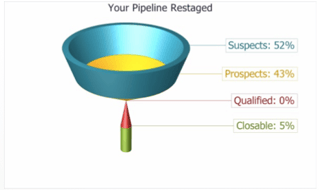Why are
You have validity and complete confidence in the credibility of your pipeline report.- Your CFO never asks you about solid sales forecasts.
- You are ok with the unpredictable ups and downs in your team’s production.
- Your top performers don’t mind carrying the load for the other 66% of the team--who typically generate 10% or less of new business sales. (Get more out of your non-performers)
The rollercoaster/anemic pipeline discussion is important if you need to know the answers to these important business questions:
- How many new leads are we really generating?
- How many of those new leads are converting to new opportunities AND what is that conversion rate?
- What is our real average size account?
- What is our closing ratio from new opportunities to closed /won accounts?
- What is the dollar volume or number of new opportunities on a rolling
90 day time frame throughout the year?

Knowing the answers to these questions helps you have better predictability from your pipeline. The answers also
Instead of telling them they need to “See more people”, “Do a better job of closing” or “Increase your average size sale”, you will have the ability to show the data so that they understand where they are lacking and must increase efforts and/or learn skills.
Here are 5 Sales Management BEST PRACTICES to eradicate the rollercoaster anemic pipeline problem, ALTHOUGH you must have a CRM system that does more than just allow your
Your CRM tool must have a milestone centric sales process format that collects information about leads every time they go to your site, read an email, or look at your LinkedIn profile. Your CRM must produce and display a dashboard with all the pertinent information that answers the questions asked above. And your CRM must have a library of content you can use to help coach your people. (Ask
BEST PRACTICES:
- You have established for each
sales person on your team a “Success Formula”. You can go to this link to download a template. The individual Success Formulas puts you and yoursales people on the same page which outlines effort and effectiveness required to meet and exceed extraordinary goals. - You have a Huddle Process to collect
real time information oneffort . The entire sales process hinges on one step – effort to generate leads. It is nothing more than effort. While skill is required, true effort in the form of necessary behavior iscritical . S. If you don’t have true “hunters”, recruit and replace. - Read and understand what the data for business intelligence.
Sales people know when they are not performing well. What they need help with is the “Why?” The business intelligence you gain from your CRM will point you in the direction of the answer to the question “What should I be doing differently to improve sales?” - Establish coaching plans for those failing (even just 5% off of target requires coaching).
**Side note: Failing is failing. Don’t lull yourself into a false sense of security with comments like, “He is close. He is trending in the right direction. He is one deal away from hitting goal.”
- Each coaching session must end with an action step: eg. “Mike, what I want you to do now is to call ABC Company and talk to your contact. Have the discussion we just role–played and report back to me by the end of business tomorrow.” Without action steps your
sales people will leave these 1-on-1 coaching sessions and promptly forget the discussions.Unfortunately by nextweek you will be wondering what they diddifferently, if anything at all.
These 5 Best Practices are not meant to be the all-inclusive list of steps required by sales managers to drive sales productivity. You must still have steps and strategies to motivate your people, recruit more of the right talent, have great sales meetings, develop teams that work together etc. But focusing on these 5 Best Practices will help you develop a more credible, valid and consistent pipeline. This is important to you, your people and the company.
Additional resources:
CRM best practices-An article by Izzy Witts at Bablequest.com
9 Keys to Coaching Sales Success Are you a great coach?


